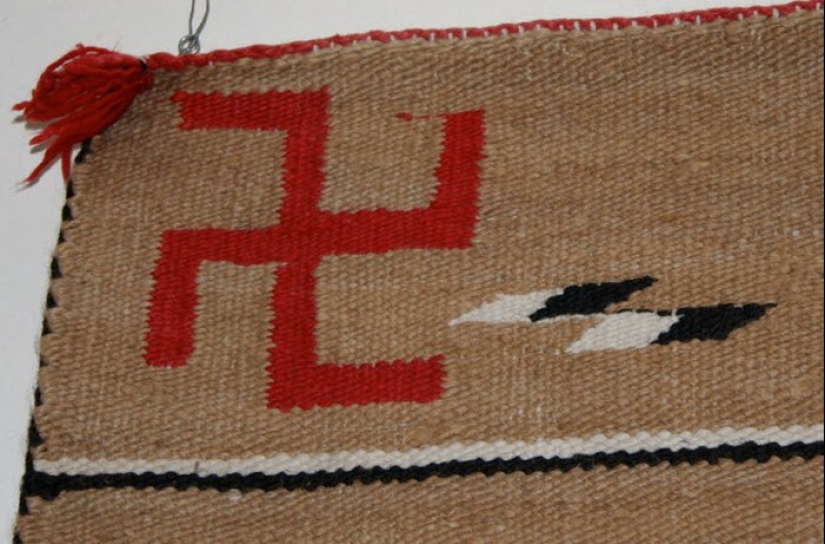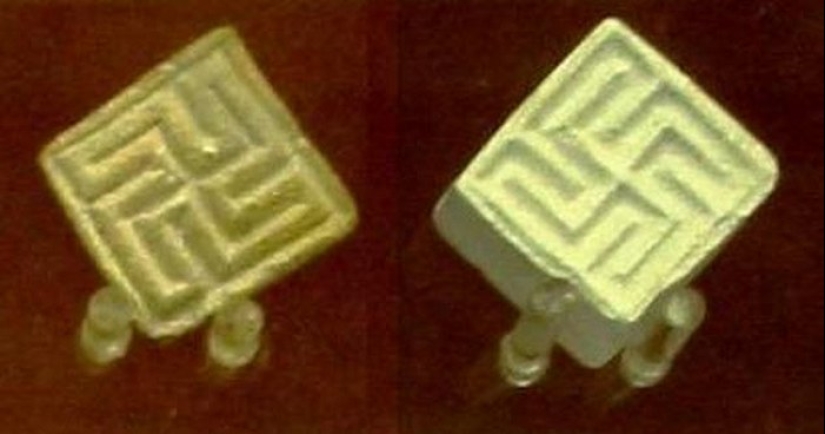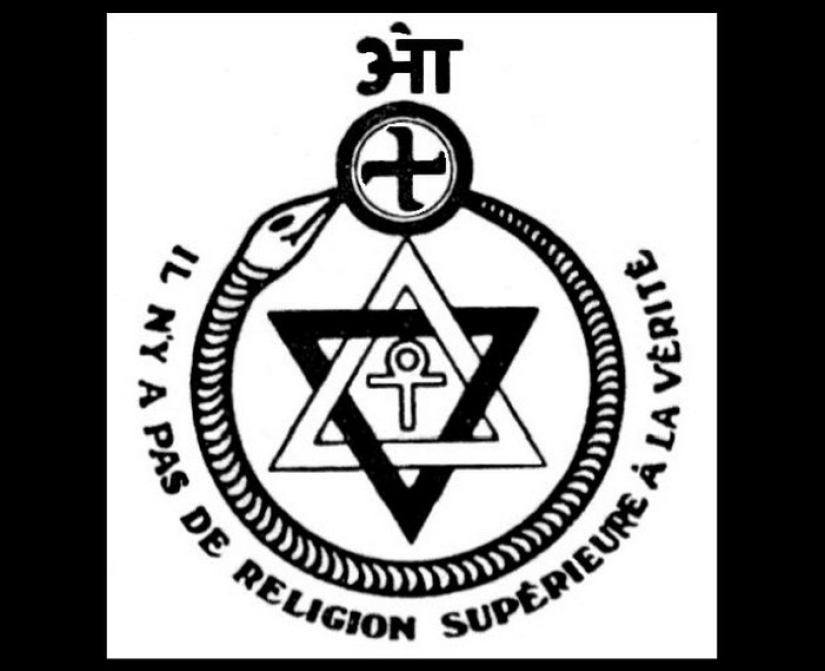10 examples of swastikas in various cultures that have nothing to do with the ideology of the Nazis
By Pictolic https://pictolic.com/article/10-examples-of-swastikas-in-various-cultures-that-have-nothing-to-do-with-the-ideology-of-the-nazis.htmlThe swastika in the modern world is one of the most recognizable symbols of evil, racism and tyranny, which is still hated by people in many countries. However, in fact, the swastika has always been a symbol of good luck, which was used in many cultures before it began to be associated with the murderous regime of the 20th century.

Absolutely analogous to the Nazi swastika, the symbol known as the "rotating log" has been used by Native American Indians in the southwestern United States for centuries, starting with the ancient Anasazi culture.

In Navajo myths, this symbol depicts the story of an outcast traveling down a river in a hollow log. At the end of his journey, he reaches an abundant and prosperous land. In some cultures, such a symbol represents the four winds or four directions.
After World War II, Navajo, Apache and Hopi Indians decided to abandon the use of swastikas on their blankets, baskets, art objects and clothing due to association with Nazi evil. In recent years, Indians have begun to use this symbol again as Native American.

In ancient Greece, there was a symbol resembling a swastika, which was known as the gammadion. It resembled the four Greek letters gamma, which were aligned so that their corners formed a common center.Early Christians used the gammadion to depict the cross of Jesus. It was also used as a secret symbol during the period when the Roman Empire persecuted Christians. Some scholars claim that the gammadion symbolizes Christ and was used by early Christians to protect against the spirits of the dead in the catacombs. And long before the emergence of Christianity, gammadion was found in almost all Mediterranean civilizations, such as the ancient Minoans, Greeks and Etruscans.

In Buddhism, the swastika (called "wang" in Chinese and "manji" in Japanese) was an important religious symbol that signified the liberation of the spirit. Swastikas of different colors had different meanings: blue symbolized the eternal benevolence of heaven, red — the boundless kindness of the Buddha, yellow — eternal prosperity, and green meant boundless perfection.The left-sided swastika is considered the first of the 65 auspicious symbols of the Buddha, and the right-sided one is considered the fourth of such symbols. In the Tibetan tradition, the Bon swastika is called gyung-drung, which means "eternal and unchangeable". Unlike other swastikas in Hindu, Buddhist and Jain traditions, the Bon swastika is directed counterclockwise. In Chinese, the character in the form of a swastika is "ten thousand" and means descent from heaven. In later times, this hieroglyph began to mean "many".

The traditional symbol of the Jain faith was the swastika, known as "gahuli", which symbolized four points, four different destinies that each soul will meet over several lifetimes, depending on their actions and karma: life as a human, animal, divine being and hellish essence.The swastika itself has several meanings. It is a wheel symbolizing the eternal nature of material existence. The four branches represent the four branches of the Jain faith: sadhu (monks), sadhvi (nuns), shravak (men) and shravikva (women). The symbol reminds Jains that their goal is liberation from reality, not rebirth in it. This can only be achieved with the help of these four pillars of the Jain community. The branches also represent the four eternal characteristics of the soul: knowledge, perception, happiness and energy.

In the Vedic tradition of ancient Hinduism, the word swastika comes from the word "swasti", which means "let only good things happen" or "well-being". This word was used to denote beauty and favorable conditions, and was also included in the rituals of farewell and congratulations. Its origin is believed to relate to the sun worship religion of the Indus Valley civilization, but later the swastika was incorporated into all currents of the developing Hindu faith.The four branches of the Hindu swastika have many meanings: the four Vedas, the four goals of life (leading to prosperity), the four stages of life (symbolizing good luck), the four directions in space (meaning the omnipresence of Brahma), the four seasons (meaning the cyclical nature of time) and the four Yugas of the world cycle (meaning the natural evolution of the universe). The swastika is closely related to the god Ganesha, who is often depicted sitting on a lotus flower above the bed in the form of a swastika.

The swastika, known as the hakaristi in Finland, has been considered a symbol of good luck in Scandinavia and the Baltic region for many thousands of years. Swedish nobleman Count Eric von Rosen considered this symbol a personal symbol of good luck, marking his luggage with it while traveling in South America and Africa.
After Finland declared its independence during the Civil War in In Russia, Rosen actually became the ancestor of the use of the swastika in the Finnish Air Force. In 1918, the blue swastika on a white background was adopted as the official symbol of Finnish aviation.

Theosophists have used the swastika symbol in various cultures and time periods throughout history. Madame Elena Blavatsky believed that the swastika was an emblem of Fohat, or cosmic electricity. Cosmic electricity is an occult Tibetan term for Daiviprakriti, the primordial light. In esotericism, it symbolizes the same thing — the universal life force.Modern theosophical societies use the right-sided swastika as a symbol of the dynamic forces of creation, representing the global process of development, and also believe that the reverse swastika, which was used by the Nazis, is a symbol of destructive forces leading to the end of the world.
Many of the early works of the British writer Rudyard Kipling were decorated with the swastika symbol. He first started using this symbol on the covers of his books at the end of the 19th century after he became familiar with the swastika in Indian art.

Both types of swastikas (clockwise and counterclockwise) appeared in his works, symbolizing good luck. Along with the swastika, Kipling often used the image of an elephant's head in homage to the Hindu god Ganesha. At the same time, Kipling despised the Nazis.

The term, which was originally used for the swastika symbol, has figured in various cultures across Europe. Some researchers correlate it with the symbol of the hammer of Thor, which may explain its presence on church bells in areas of England such as Yorkshire and Lincolnshire, which were influenced by Norwegian culture. This symbol is sometimes called the "sign of the hammer of Thor" or the "cross of Thor".The possible meanings of the four branches of the swastika are seasons (winter solstice, spring equinox, summer solstice, autumn equinox), seasons (winter, spring, summer and autumn), phases of life (birth, life, death and rebirth), phases of day (night, morning, afternoon and evening), elements (air, fire, water and earth), the phases of the Moon (lunar eclipse, growth, full moon and waning) and the main directions (north, east, south and west).
The founder of the alien cult Rael used a controversial symbol in his movement — a combination of a swastika with a star of David. He claimed to have seen this symbol on the hull of the ship of the Elohim, aliens from outer space.

The star of David supposedly symbolizes infinity in space, while the swastika symbolizes the infinity of time. The common symbol denotes the relationship between time and space, eternity and infinity. All Raelites wear a medallion with this symbol.
Recent articles

Most men want to see in a woman at the same time a passionate lover in bed, a good hostess in the kitchen and a faithful friend in ...

Cats are everywhere, where live and work people. There are some in the places where they seemingly did not place. For example, in ...

Photography is an art, and a person with a camera who creates something unique has every right to be called an artist. But among ...